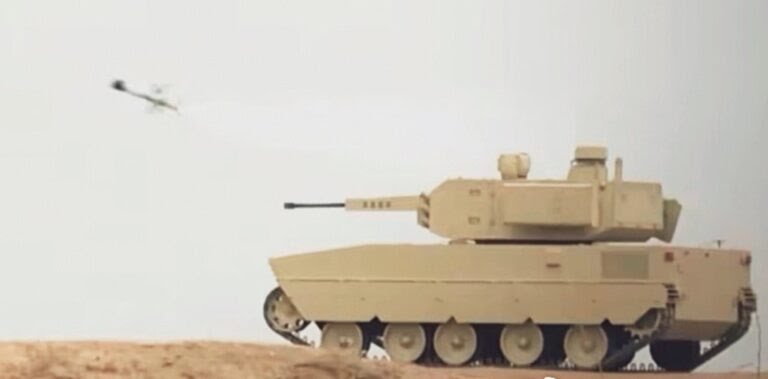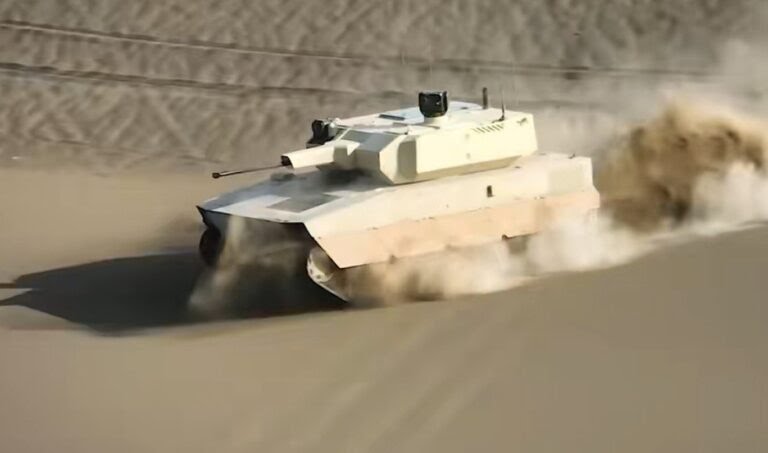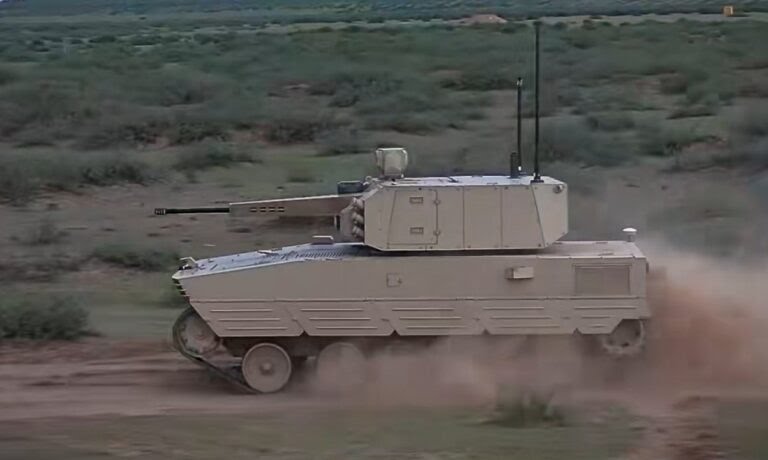China has taken a bold leap into the future of military technology by unveiling the VU-T10, a fully robotic tank that could redefine how battles are fought in the years to come. Unveiled through a promotional video by NORINCO (China North Industries Group Corporation), the VU-T10 demonstrates remarkable autonomous and remote controlled capabilities, combining modern firepower with AI assisted maneuverability. The introduction of this robotic tank underlines Beijing’s ambition to become a dominant force in autonomous warfare.
VU-T10 The Next Frontier in Combat Robotics
Weighing approximately 11 tons, the VU-T10 is not just a concept it’s a fully functioning prototype showcased maneuvering across rugged terrain, engaging targets with precision. Its weapons include a 30mm automatic cannon and a 7.62mm coaxial machine gun. Additionally, it’s equipped with banks of electrically operated smoke grenade launchers to protect against enemy countermeasures.
According to NORINCO’s promotional footage, the VU-T10 navigates harsh, uneven landscapes with surprising agility, showcasing its battlefield readiness. A close analysis of the vehicle’s trials suggests that it is intended for a wide range of operations, including border patrol, support roles, and high risk reconnaissance missions areas where traditional manned vehicles might be exposed to unnecessary risk.
Expert Opinions on the Rise of Robotic Warfare
Dr. Lin Yao, a defense analyst at Tsinghua University, notes, “The VU-T10 robotic tank marks China’s growing focus on integrating AI with battlefield machinery. It reflects a broader strategic shift, aiming to minimize human casualties while increasing precision and efficiency in future conflicts.”
Western defense experts are also watching China’s robotic advancements with keen interest. Col. Richard Mason (Ret.), a former U.S. Army robotics commander, shared, “This move isn’t surprising. China has invested heavily in AI, machine learning, and unmanned ground systems. The VU-T10 is a message to the world it shows that China is serious about fielding robotic forces alongside traditional military hardware.”

The Evolution of Unmanned Ground Vehicles (UGVs)
To understand the significance of the VU-T10, we need to look at the global evolution of UGVs. Over the past two decades, countries like the U.S, Russia, and Israel have been experimenting with unmanned armored platforms. For example:
Russia’s Uran-9: Equipped with autocannons and anti tank missiles, it was tested in Syria but faced setbacks in mobility and connectivity.
U.S. Army’s RCV (Robotic Combat Vehicle): Currently in development with a focus on semi autonomous operation, remote engagement, and swarm tactics.
Israel’s Jaguar UGV: Deployed for border patrol, it features sensors, surveillance equipment, and remote weapons systems.
In comparison, China’s VU-T10 appears more refined and combat-ready. Unlike earlier prototypes from other nations, the VU-T10 displays smooth terrain handling and integrated firepower, suggesting it’s ready for live deployment trials.
Strategic Implications of Robotic Tanks
The deployment of robotic tanks like the VU-T10 could significantly alter traditional military doctrine. Here are several strategic implications.
1. Reduced Human Risk: Robotic tanks reduce the exposure of soldiers to front-line dangers, especially in high threat or urban environments.
2. Enhanced Surveillance & Reconnaissance: With AI powered sensors, VU-T10 can provide real time intelligence without risking human lives.
3. Cost Effective Warfare: While initial R&D costs are high, robotic platforms reduce the need for expensive life support systems in vehicles.
4. 24/7 Operational Capability: Unlike human operators, machines don’t require rest, allowing continuous operations in prolonged conflicts.
Major Zhu Jianguo, who participated in the VU-T10’s test trials, stated, “The tank performed with high efficiency even during night operations. The remote weapon system’s responsiveness and real time targeting accuracy were beyond our expectations.”
Personal Experience from a NORINCO Engineer
Liu Chen, a senior robotics engineer at NORINCO, shared insights into the development process, The VU-T10 was born out of years of AI research and real time terrain mapping systems. We designed it to mimic the instincts of a skilled human operatorbwithout fatigue, hesitation, or fear.
He also emphasized the importance of field feedback. “Our trials involved simulated combat conditions with moving targets, simulated mines, and electronic warfare. We constantly iterated based on what we observed in the field.”

Ethical Concerns and International Reactions
While the technology is groundbreaking, it’s not without criticism. The development of robotic tanks raises pressing questions about autonomy, accountability, and ethical warfare.
Human Rights Watch has long argued that autonomous weapons pose serious risks of unlawful harm. Their 2024 report on lethal autonomous weapons warned, “When machines decide to kill, accountability becomes diluted. It’s essential that countries establishing robotic forces maintain human oversight.”
Meanwhile, countries like the U.S. and the EU have pushed for regulations to ensure that all autonomous weapon systems maintain a ‘human in the loop’ standard meaning a human must make the final decision to fire a weapon.
The Future Outlook for China’s Robotic Forces
The unveiling of the VU-T10 is just the beginning. China has already announced plans for a family of unmanned combat vehicles, including larger robotic main battle tanks and AI enhanced logistics carriers. The Chinese military’s doctrine is shifting toward a “smart war” model, integrating satellite systems, AI decision making, and unmanned platforms into a single, cohesive force.
In this vision of the future, robotic tanks like the VU-T10 will work alongside drones, cyber-units, and human soldiers to form a synchronized, AI driven military machine.
A Watershed Moment in Modern Warfare
The VU-T10 represents more than a technological milestone it symbolizes a paradigm shift in modern warfare. As China aggressively pushes the boundaries of military AI, the global balance of power is being reshaped by autonomous systems. With the robotic tank now a reality rather than a concept, military strategists around the world must reconsider how wars will be fought and who, or what, will do the fighting.


1 thought on “The VU-T10 Robotic Tank: A Game Changer in Future Warfare”